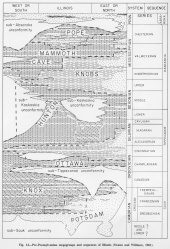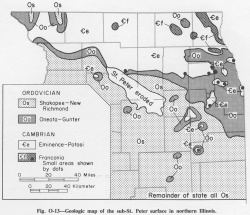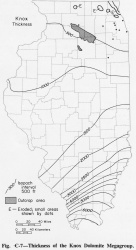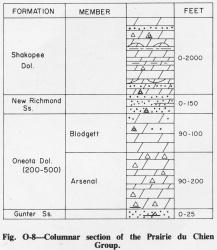Knox Dolomite Megagroup
Lithostratigraphy: Knox Dolomite Megagroup
Chronostratigraphy: Paleozoic Erathem >>Cambrian System >>Croixan Series >>Dresbachian Stage
Allostratigraphy: Sauk Sequence
Primary source
Willman, H. B., Elwood Atherton, T. C. Buschbach, Charles Collinson, John C. Frye, M. E. Hopkins, Jerry A. Lineback, and Jack A. Simon, 1975, Handbook of Illinois Stratigraphy: Illinois State Geological Survey Bulletin 95, 261 p.
Contributing author(s)
T. C. Buschbach
Name
Original description
Knox Dolomite Megagroup (Safford, 1869, p. 151, 158-159; Swann and Willman, 1961, p. 477).
Derivation
Named for Knox County, Tennessee.
Other names
History/background
Type section
Type location
Type author(s)
Type status
Reference section
Reference location
Reference author(s)
Reference status
Stratigraphic relationships
The unit underlies the St. Peter Sandstone and overlies either the Potsdam Sandstone Megagroup or, as in much of Illinois, the interbedded sandstone and dolomite that is not included in either the Potsdam or the Knox Megagroups. The Knox Megagroup includes strata of Cambrian (Croixan) and Ordovician (Canadian and Chazyan) age (figs. 14, Є-3).
The southward thickening of the Knox is related to northward truncation of the upper part of the Shakopee Dolomite and also to inclusion of the Everton Dolomite at the top of the megagroup in the extreme southern part of the state. In addition, the Franconia Formation and the Ironton and Galesville Sandstones grade southward into dolomite, resulting in repeated lowering of the base of the Knox until it reaches the top of the Mt. Simon Sandstone. In the northern part of the state, where the Knox is partly exposed and many wells penetrate the formations, the Knox is differentiated into several formations, which lessens the need to recognize the megagroup. In southern Illinois where the distinguishing characteristics of many formations disappear and the formations cannot be differentiated, the megagroup is more essential.
Extent and thickness
The Knox underlies all of Illinois except small areas in northern Illinois where the sub-Tippecanoe unconformity cuts entirely through the dolomite formations and the St. Peter Sandstone rests on the Franconia Formation or, locally, on the Ironton Sandstone (fig. O-13). The sandstones generally thin southward and disappear near the middle of the state. The megagroup, on the other hand, thickens southward from 300-500 feet in much of northern Illinois to more than 6000 feet in extreme southern Illinois (fig. Є-7).
Lithology
The Knox Dolomite Megagroup is relatively pure dolomite. Although dominantly dolomite, in the northern part of the state the megagroup contains relatively thin sandstones-- the New Richmond and Gunter Sandstones, the Momence Sandstone Member of the Eminence Formation, the Jordan Sandstone, and numerous thin beds in the Shakopee Dolomite (figs. Є-3, O-8).
Core(s)
Photograph(s)
Contacts
Well log characteristics
Fossils
Age and correlation
The Knox Dolomite Megagroup is equivalent to the Knox Formation or Knox Group, as it is called in states south and east of Illinois, and to the Arbuckle and Ellenberger Formations or Groups in states to the southwest.
Environments of deposition
Economic importance
Remarks
References
SAFFORD, J. M., 1869, Geology of Tennessee: S. C. Mercer, Nashville, Tennessee, 550 p.
SWANN, D. H., and H. B. WILLMAN, 1961, Megagroups in Illinois: American Association of Petroleum Geologists Bulletin, v. 45, p. 471-483; Illinois State Geological Survey Reprint 1961-N.
ISGS Codes
| Stratigraphic Code | Geo Unit Designation |
|---|---|




